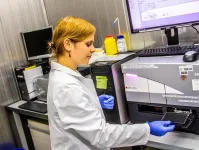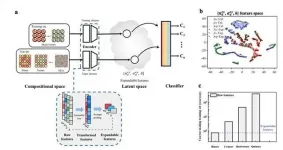Hepatitis B: What people can learn from donkeys
The discovery of a previously unknown hepatitis B virus in donkeys and zebras opens up new opportunities for understanding the course of the disease
2021-03-17
(Press-News.org) Hepatitis B virus (HBV) infections are among the major global health problems. Particularly problematic is the high number of chronic courses of the disease, causing the deaths of more than 800.000 people globally every year. So far, there is no therapy to cure the condition. "With the discovery of a new hepatitis B virus in donkeys and zebras capable of causing prolonged infections, we now have the opportunity for a better understanding of the chronic course of the disease and thus also for mitigation or prevention of severe clinical consequences," explains Prof. Dr. Jan Felix Drexler, DZIF researcher at the Charité - University Medicine Berlin. In the German Center for Infection Research (DZIF), he identifies and characterizes emerging viruses that could be dangerous for humans.
"Five years ago we were able to show for the first time that donkeys harbor viruses that are genetically related to the human hepatitis C virus," explains Andrea Rasche, lead author of the study and DZIF scientist at the Charité - University Medicine Berlin. Since HBV and the hepatitis C virus (HCV) often occur together in humans, the researchers have also searched for HBV worldwide in donkeys. In addition to field work, extensive molecular, serological, histopathological and evolutionary biology methods were used. "We have studied nearly 3000 samples from equids, i.e. from donkeys, zebras and horses in five continents, and we found that donkeys are global carriers of the new hepatitis B virus," explains Drexler.
The origins of the new HBV could be linked to the domestication of donkeys in Africa a few thousand years ago. Donkeys are naturally infected with HBV as well as with HCV. Zebras are also infected with HBV; horses are also likely to be receptive, but in initial studies, the scientists could not confirm any naturally infected horses. In naturally infected donkeys, the course of the infection is similar to chronic hepatitis B in humans.
"The new hepatitis B virus appears to use an unknown receptor for entry into the host cell," explains Felix Lehmann, second lead author of the study and DZIF scientist at Giessen University (JLU) where he studied the molecular biology of virus binding and entry in cell culture. The emergence of human HBV and the development of its receptor use remain unclear and are jointly investigated by the researchers from Berlin and Giessen.
"Since the virus is unable to infect human liver cells, human infection with this virus can be ruled out with a high degree of probability," emphasises Prof. Dr. Dieter Glebe, Head of the National Reference Centre for Hepatitis B and D viruses at JLU and DZIF scientist in the "hepatitis" research unit. The scientists are convinced that with the virus in donkeys and zebras, they can develop a better understanding of the pathogenesis of chronic hepatitis B and of HBV/HCV co-infection to lay a foundation for new therapies.
INFORMATION:
[Attachments] See images for this press release:

ELSE PRESS RELEASES FROM THIS DATE:
2021-03-17
A new study uncovers which cell types can be infected by SARS-CoV-2 due to their viral entry factors. The study also suggests that increased gene expression of these viral entry factors in some individuals partially explains the differences of COVID-19 severity reported in relation to age, gender and smoking status. The study evolved from the Human Cell Atlas Lung Biological Network with main contributions from Helmholtz Zentrum München, the Broad Institute of MIT and Harvard, the Wellcome Sanger Institute and University Medical Center Groningen.
COVID-19 does not affect everyone in the same way. While the coronavirus SARS-CoV-2 primarily ...
2021-03-17
The health of women aged 65 and over appears to be related, in addition to their own socioeconomic characteristics, with that of their partners, as a result of traditional gender norms. This is one of the main conclusions of research led by Jordi Gumà, a researcher at the UPF Department of Political and Social Sciences, conducted in conjunction with Jeroen Spijker, a Ramon y Cajal I3 researcher at the Centre for Demographic Studies of the Autonomous University of Barcelona (CED-UAB), focusing on the case of Spain.
The study, published in Gaceta Sanitaria, analyses the health differences among the Spanish ...
2021-03-17
An international team of scientists from the University of Turku, Finland and PennState University, USA have solved a long-standing mystery of how living organisms distinguish RNA and DNA building blocks during gene expression paving the way for the design of new antiviral drugs. The new insights were published in the journal Nature Communications.
All cellular organisms use two types of nucleic acids, RNA and DNA to store, propagate and utilize their genetic information. The synthesis of DNA is carried out by enzymes called DNA polymerases and is needed to accurately transfer the genetic information from generation to generation. ...
2021-03-17
Our immune system is very successful when it comes to warding off viruses and bacteria. It also recognizes cancer cells as potential enemies and fights them. However, cancer cells have developed strategies to evade surveillance by the immune system and to prevent immune response.
In recent years, fighting cancer with the help of the immune system has entered into clinical practice and gained increasing importance as a therapeutical approach. Current therapies apply so-called immune checkpoint inhibitors. Immune checkpoints are located on the surface ...
2021-03-17
A single-celled alga undergoes genome surgery to remove non-essential parts. This can lead to a most efficient cellular factory for producing sustainable biofuels from sunlight and carbon dioxide.
Researchers from the Qingdao Institute of BioEnergy and Bioprocess Technology (QIBEBT) of the Chinese Academy of Sciences (CAS) have stripped hundred-kilobase genome from a type of oil-producing microalgae, knocking out genes non-essential for it to function. By doing so, they have created a "genome scalpel" that can trim microalgal genomes rapidly and creatively.
The 'minimal genome' microalgae produced is potentially useful as a model organism for further study of the molecular and biological function of every gene, or as a 'chassis' strain for synthetic biologists to augment for customized ...
2021-03-17
RALEIGH, N.C. -- Methane hydrate, an ice-like material made of compressed natural gas, burns when lit and can be found in some regions of the seafloor and in Arctic permafrost.
Thought to be the world's largest source of natural gas, methane hydrate is a potential fuel source, and if it "melts" and methane gas is released into the atmosphere, it is a potent greenhouse gas. For these reasons, knowing where methane hydrate might be located, and how much is likely there, is important.
A team of researchers from Sandia National Laboratories and the U.S. Naval Research Laboratory have developed a new system to model the likelihood of finding methane ...
2021-03-17
Cutting-edge 3D scanners have been put to the test by researchers from the University of Southampton and partners Exceed Worldwide to help increase the quality and quantity of prosthetics services around the world.
The study, carried out within the END ...
2021-03-17
A team of scientists led by Dietmar Krautwurst from the Leibniz Institute for Food Systems Biology at the Technical University of Munich has now identified address codes in odorant receptor proteins for the first time. Similar to zip codes, the codes ensure that the sensor proteins are targeted from inside the cell to the cell surface, where they begin their work as odorant detectors. The new findings could contribute to the development of novel test systems with which the odorant profiles of foods can be analyzed in a high-throughput process and thus could be better controlled.
The ...
2021-03-17
Alchemy, which attempted to turn cheap metals such as lead and copper into gold, has not yet succeeded. However, with the development of alloys in which two or three auxiliary elements are mixed with the best elements of the times, modern alchemy can produce high-tech metal materials with high strength, such as high entropy alloys. Now, together with artificial intelligence, the era of predicting the crystal structure of high-tech materials has arrived without requiring repetitive experiments.
A joint research team of Professor Ji Hoon Shim and Dr. Taewon Jin (first author, currently at KAIST) of POSTECH's Department of Chemistry, and Professor Jaesik Park of POSTECH Graduate School of Artificial Intelligence have together developed a system that predicts ...
2021-03-17
TROY, N.Y. -- Numeric anchoring is a long-established technique of marketing communication. Once a price is mentioned, that number serves as the basis for -- or "anchors" -- all future discussions and decisions. But new research shows that this phenomenon is not limited to decisions that involve numbers, the use and understanding of which require high-level cognitive thinking. Anchoring also biases judgments at relatively low levels of cognition when no numbers are involved.
In research recently published in the Journal of Behavioral Decision Making, Gaurav Jain, an assistant professor in the Lally School of Management at Rensselaer Polytechnic Institute, demonstrated that anchoring even occurs in perceptual domains, ...
LAST 30 PRESS RELEASES:
[Press-News.org] Hepatitis B: What people can learn from donkeys
The discovery of a previously unknown hepatitis B virus in donkeys and zebras opens up new opportunities for understanding the course of the disease






